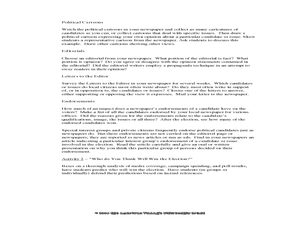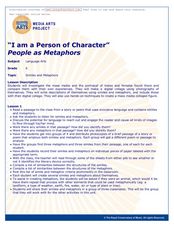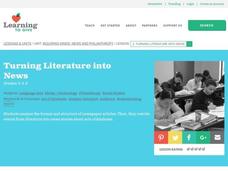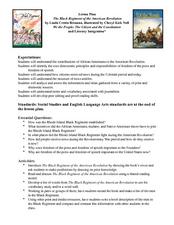Curated OER
Violence on TV and Our Response
Students examine violence on television. In this media awareness lesson, students discuss the types of fictional and realistic violence shown on American television. Students participate in a Congressional simulation activity on the...
Curated OER
Bias vs. Perspective: An Inevitable Aspect of Journalism?
Students explore the types of media that U.S. teens prefer the ways in which viewers identify and account for journalistic bias. They explore the ways in which media shapes one's opinion or affects their judgment.
Curated OER
The Campaign: Issues and Strategies. What do you think?
Young scholars research a candidate in an election and discuss how the media portrays that candidate and how the media influences voters. In this candidate lesson plan, students also distinguish fact from opinion, look at political...
Curated OER
I Am a Person on Character
Sixth graders explore the portrayal of males and females in mass media. For this language arts lesson, 6th graders create a digital collage and write a description about themselves using similes and metaphors.
Curated OER
Benjamin Franklin: Colonial Printer and Journalist
Fifth graders explore how important print media is to everyone's daily life. Students use present daily newspapers and they are to reproduce weather forecasts.
Curated OER
Food Advertising Tricks
Students recognize techniques used to make food look appealing on television and in advertising, and explore the separate elements that compose media messages and products.
Curated OER
What's in the News Today?
Students examine the media and the responsibility of reporting facts to readers. In this journalism instructional activity, students identify the different types of media, the different parts of a news story, and how the stories are...
Curated OER
Supplementary Angles
Students develop an understanding of the journalistic concept of the "news angle," by examining the newspaper coverage of an airplane disaster.
Curated OER
Inquiring Minds: News and Philanthropy
Students study newspaper articles and rewrite events from literature into news stories about kindness. In this news article lesson, students read sentences from newspaper articles and identify the purpose of the article. Students...
Curated OER
Using the News in Class
Students listen to international news stories. Students use context clues to determine the meaning of vocabulary words from context, then complete a matching exercise to see if their vocabulary definitions were correct. Students...
National First Ladies' Library
Michigan vs. Ohio State: A Serious Rivalry!
Middle schoolers discuss and research the pros and cons of school rivalries. In particular, they study the Michigan-Ohio State rivalry. Through their research, they think about how media accounts of college football games can be shaped...
Social Media Toolbox
Twitter Time
Tweet all about it! Junior journalists explore the Twittersphere to determine its effectiveness as a news broadcasting tool in the 12th installment of the 16-part Social Media Toolbox. Participants follow and record their observations of...
Social Media Toolbox
Verification
When you're putting together a great story, you've got to consider the source! Scholars discover the dangers of errors in reporting during the 14th activity in a 16-part Social Media Toolbox series. Groups collaborate to create a source...
Kent State University
Teaching Ethics in Scholastic Journalism
Events in recent years have underscored the importance of a free and independent press in a democracy. Young journalists engage in lessons about the function of journalism in a democratic society, practice the steps of Bok's Ethical...
Curated OER
We the People: The Citizen and the Constitution: The American Revolution
The contributions of African-Americans to the American Revolution are the focus of this Social Studies and language arts lesson. After reading and discussing Linda Crotta Brennan’s The Black Regiment of the American Revolution, class...
iCivics
Lesson 3: Bias
How do journalists balance bias and ethical reporting? The final lesson in a series of five from iCivics examines the different types of bias and how they affect the news we read. Young reporters take to the Internet to find examples of...
Curated OER
Health: Media and Body Image
Fifth graders examine the influence of advertisements on body image and purchasing. They discuss the psychology behind the ads and working in groups cut out words in magazine advertisements that could entice them to buy the product. ...
Curated OER
Lesson Plan: The Black Press
Students examine the history of the black press. In this media awareness lesson, students watch videos and conduct research regarding the history of the black press in America. Students explore media careers as they read provided...
Curated OER
Media Stereotypes: How Differences Divide
Students differentiate between generalizations and stereotypes and compare and contrast gender representation. Finally, they critically analyze media for gender stereotypes. They look at magazines and create collages to focus in on the...
Curated OER
Finding Content/Media
Sixth graders use the web to find and download photos, images, and clip art to create a large library of images in a short time. They survey audio and video files and other media by using various search engines. Remember to follow...
Curated OER
The Media and Social Justice in the United States
Middle schoolers investigate why the hip hop is sometimes called the CNN of black youth. They explore the political themes in American hip hop. Students examine the connection between art, media and social justice in hip hop.
Curated OER
Critical Viewer Activity
Students practice media awareness. In this media awareness lesson, students analyze print and electronic media messages. Students discover how advertisers use re-imaging to manipulate photographs and discuss how they can become critical...
Curated OER
Mixed-Media Self-Portrait with Symbols
Young scholars watch segments of a video to explore portraits. They create a self portrait using mixed-media.
Curated OER
You Are There: Television News Reports on Apartheid
Students, in groups, research apartheid and its effects on South Africa. They present their information to the class.

























